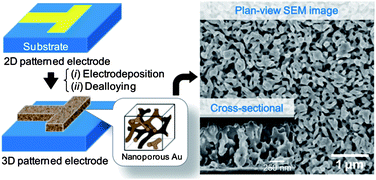Facile synthesis of nanostructured gold for microsystems by the combination of electrodeposition and dealloying†
Abstract
For the successful exploitation of microelectrochemical systems, e.g., micro-sensors and micro-

* Corresponding authors
a
International Center for Materials Nanoarchitectonics, National Institute for Materials Science, Ibaraki, Japan
E-mail:
TOMINAKA.Satoshi@nims.go.jp
For the successful exploitation of microelectrochemical systems, e.g., micro-sensors and micro-

 Please wait while we load your content...
Something went wrong. Try again?
Please wait while we load your content...
Something went wrong. Try again?
S. Tominaka, J. Mater. Chem., 2011, 21, 9725 DOI: 10.1039/C1JM10435G
To request permission to reproduce material from this article, please go to the Copyright Clearance Center request page.
If you are an author contributing to an RSC publication, you do not need to request permission provided correct acknowledgement is given.
If you are the author of this article, you do not need to request permission to reproduce figures and diagrams provided correct acknowledgement is given. If you want to reproduce the whole article in a third-party publication (excluding your thesis/dissertation for which permission is not required) please go to the Copyright Clearance Center request page.
Read more about how to correctly acknowledge RSC content.
 Fetching data from CrossRef.
Fetching data from CrossRef.
This may take some time to load.
Loading related content
